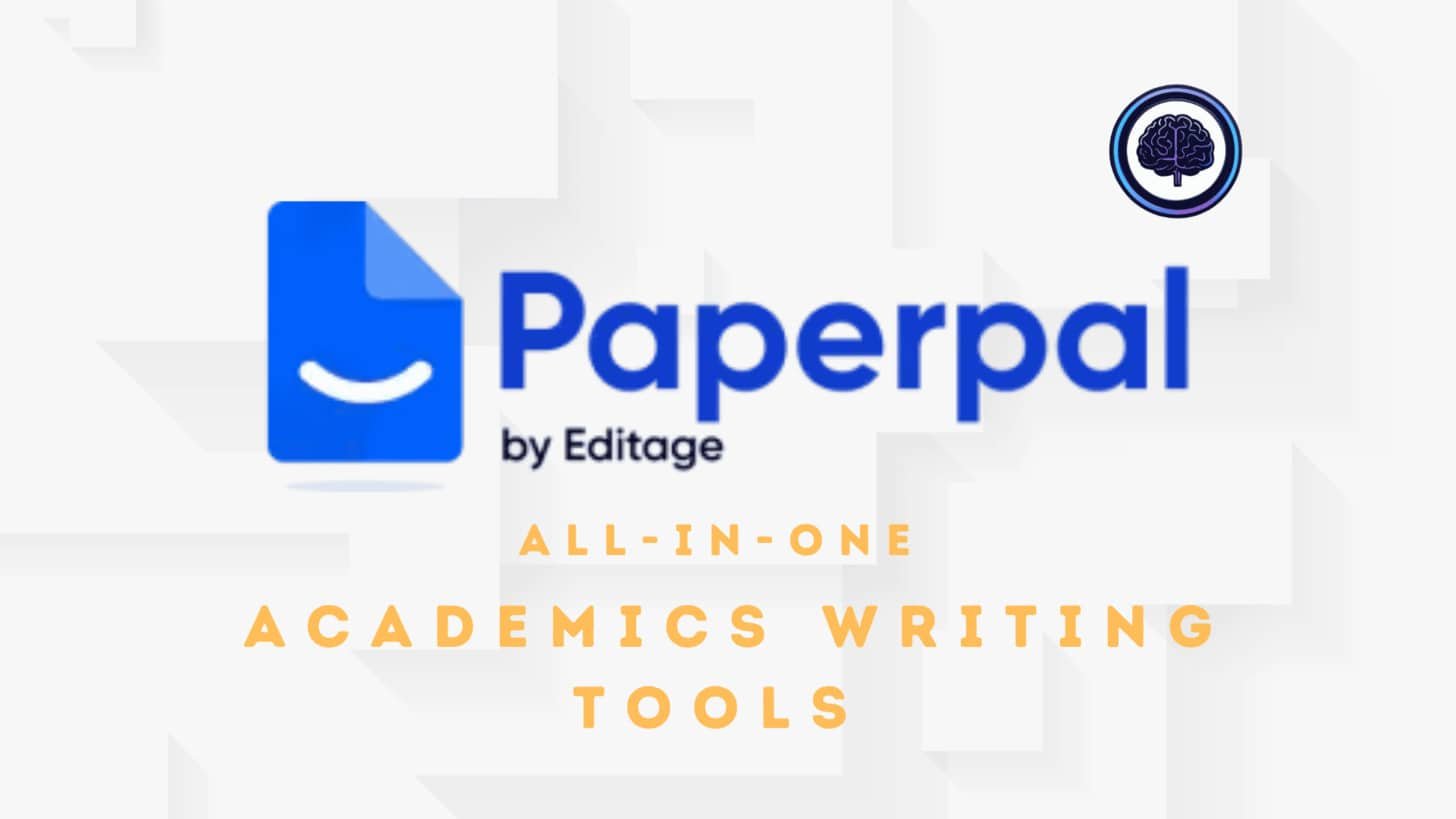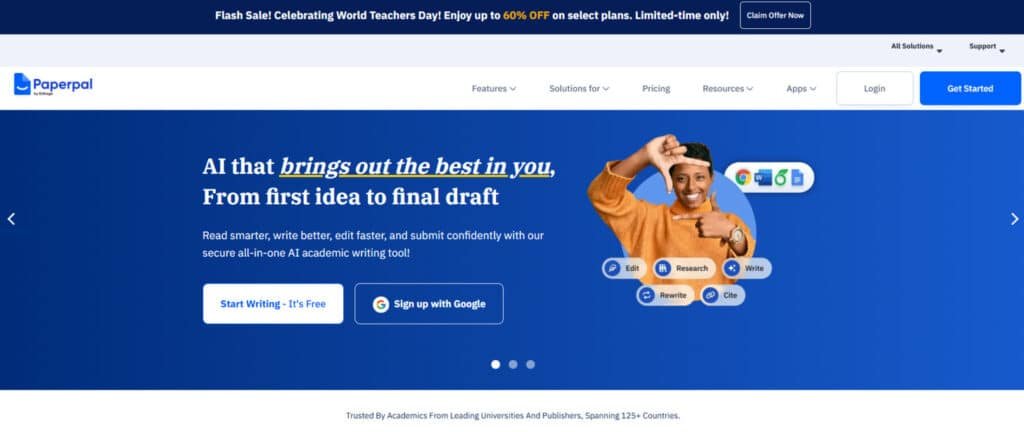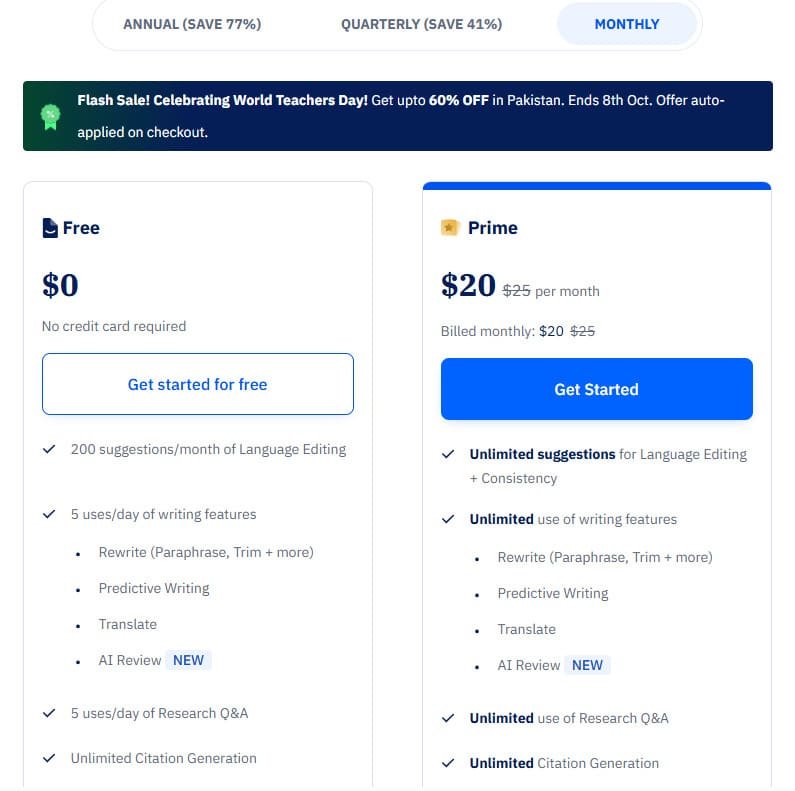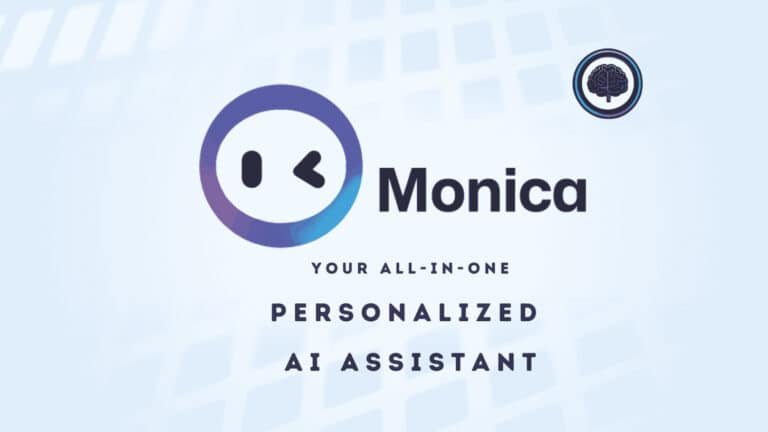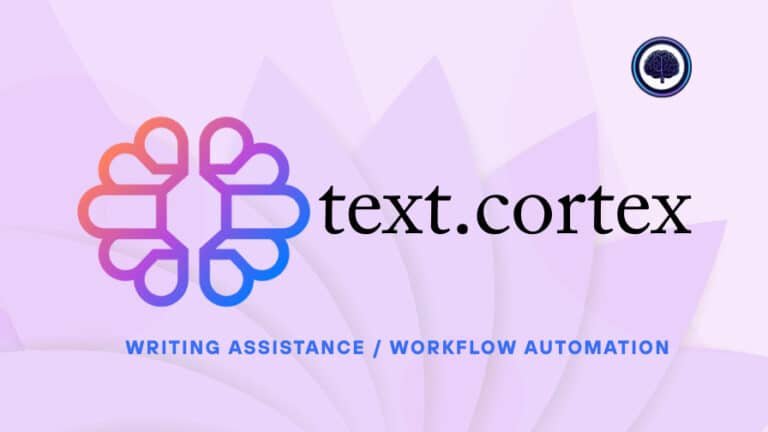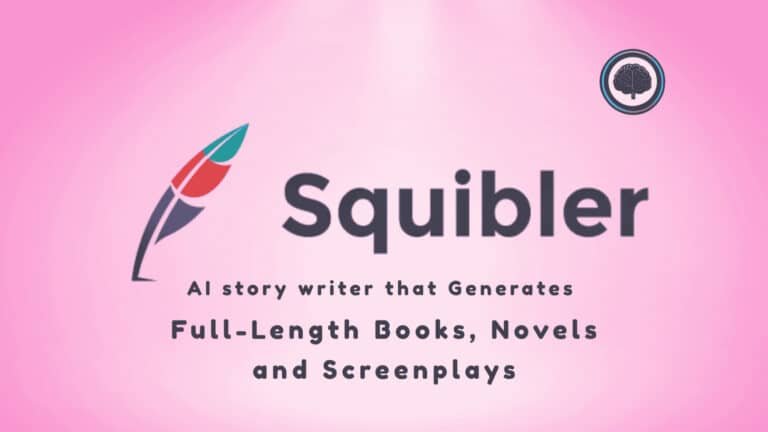Problem: You need to finish a manuscript, but juggling drafts, citations, and journal rules eats your time and drains focus. Academic writing demands clarity, compliance, and a tight schedule—yet most writing tools miss the mark on scholarly needs.
Agitation: That gap means late nights, anxiety over submission checks, and edits that don’t actually improve quality. You worry about plagiarism scans, publisher formats, and whether automated suggestions fit your language or field.
Solution: I tested an AI writing assistant built on millions of scholarly texts and decades of domain expertise. It combines edit, rewrite, research, translate, and submission-readiness checks to speed up drafts while aiming to protect quality. In this hands-on take I map each feature to real research tasks and show when to use the tool — and when a human editor is better.
Expect a clear verdict, a practical case study, and an FAQ that answers the questions grad students and faculty ask most. Let’s dive in.
Key Takeaways
- I show how this academic writing assistant handles drafts to submission checks.
- We compare free limits versus paid plans and real time saved.
- Features—research, translate, and plagiarism scans—are mapped to tasks you do.
- You’ll learn when to use automated suggestions and when to get human edits.
- The article ends with a clear verdict, pros/cons, and alternative writing tools.
Introduction to Paperpal: Where It Fits in Today’s AI Writing Landscape
For academics who need more than grammar fixes, this assistant brings research-aware support to the drafting process. I find it sits between general grammar checkers and full editorial services—built for scholarly work, not casual prose.
Who’s behind it and why pedigree matters: the system is trained on millions of academic texts across 1,300+ fields and backed by 22+ years of STM editorial expertise. It is bundled within a wider academic ecosystem (Editage All Access) so AI features link to professional publication services.
Who uses it and why it matters now
Students, researchers, medical professionals, educators, and science journalists use this assistant for theses, grant proposals, and papers. They want suggestions that respect journal structure, style, and academic tone.
- Use case: speed up drafting and idea exploration without losing field-specific accuracy.
- Team benefit: keep consistent language across lab documents during busy submission cycles.
- Research advantage: features like Research & Cite serve literature-heavy projects with real citations.
What is Paperpal?
This assistant reads your draft like an editor and returns context-aware fixes.
How it works under the hood for academic text
I found the system is trained on millions of scholarly texts, so it recognizes discipline-specific phrasing and journal norms. It scans your text to surface context-aware language suggestions—from grammar and usage to higher-level structure.
The engine keeps meaning intact while proposing corrections. Modules—Edit, Rewrite, Write, Research & Cite, Translate, Templates, and Submission-Readiness—work together to give targeted help. Integration with a Web editor and a Microsoft Word add-in keeps suggestions inside your usual workflow.
Key benefits for users at a glance
- Faster revision cycles: fewer passes to fix grammar, layout, and citation issues.
- Fewer errors: context-aware corrections reduce awkward sentences and factual mismatches.
- Better clarity: rewrite and write features help tighten arguments and expand gaps.
- Research time saved: Research & Cite finds and formats references in minutes.
- Multilingual support: Translate preserves technical terms across languages.
Best Features
This section walks through the core features that most changed my writing workflow. Below I highlight each feature, what it does, and where it helps most in academic writing.
1 Research and Citation Tools
Paperpal’s research and citation tools serve as essential components for academics engaged in scholarly pursuits.
These tools draw from a vast database to provide reliable support, ensuring that users can integrate credible sources efficiently into their work.
For those searching for ways to streamline literature reviews, this functionality offers quick access to verified information, reducing the effort required for initial research phases.
1.1 AI Reference Finder
The AI Reference Finder enables users to search for relevant academic papers using keywords, titles, or DOIs.
It delivers science-backed answers from over 250 million articles, helping researchers locate precise references that strengthen arguments in papers.
This feature assists readers by minimizing manual database searches, allowing focus on analysis rather than hunting for sources, which is particularly useful for drafting theses or journal submissions.
1.2 Citation Generator
The Citation Generator automates the creation of in-text and full citations in more than 10,000 styles, such as APA or MLA. It integrates seamlessly during writing, ensuring compliance with publication standards.
For academics preparing manuscripts, this tool provides immediate feedback on formatting accuracy, preventing citation errors that could delay approvals and enhancing the overall quality of academic text.
1.3 Research and Cite
Research and Cite offers tailored responses to queries, including recent insights filtered by publication year, with direct citations embedded.
This supports users in building evidence-based narratives without interruptions. Readers benefit by gaining faster access to literature-validated content, which aids in constructing robust sections of papers and provides the assistance needed to cite sources accurately, fostering efficiency in academic workflows.
2 Writing and Generative AI Assistance
In the realm of writing and generative AI assistance, Paperpal stands out as a specialized writing tool for academic paper composition.
It helps users overcome challenges in drafting by offering context-aware suggestions, making it a preferred choice for those seeking structured support in producing high-quality content.
This section explores how these elements enhance productivity for individuals focused on scholarly output.
2.1 Generative AI (Copilot)
Generative AI, or Copilot, functions as a proprietary toolkit for brainstorming outlines, titles, abstracts, or even professional email drafts.
It generates context-specific ideas without full text creation, promoting ethical authorship.
For readers intent on refining ideas, it delivers targeted feedback that accelerates the ideation process, ensuring papers align with academic norms and saving time on initial structuring.
2.2 AI Writing Assistant
The AI Writing Assistant provides real-time predictive text suggestions and pre-set prompts for essays or proposals.
As a core writing tool, it expands user inputs into polished drafts, doubling writing speed. This aids academics by offering continuous feedback on phrasing, helping maintain flow and relevance in text on their paper, which is ideal for those compiling extensive documents like dissertations.
2.3 AI Essay Writer
AI Essay Writer generates structured drafts from prompts or notes, tailored to academic standards.
It supports section-by-section development, ensuring logical progression.
Users searching for drafting efficiency find value in its ability to produce coherent text, with built-in feedback mechanisms that refine arguments, making it a strong choice for students tackling assignments or preliminary papers.
2.4 Brainstorm Feature
The Brainstorm Feature suggests topics, research tips, and presentation ideas to kickstart projects. It provides diverse angles for exploration, aiding initial planning.
Readers gain from this by receiving actionable feedback that sparks creativity, helping transform vague concepts into focused outlines for academic papers and enhancing overall preparation.
2.5 AI Review
AI Review evaluates drafts for clarity, structure, and logic, acting as a virtual coach for submission readiness.
It flags inconsistencies early, offering revision guidance. This feature helps users by providing detailed feedback on content quality, ensuring text meets publishing criteria and reducing revision cycles in academic writing.
3 Editing and Language Enhancement
Editing and language enhancement features in Paperpal address common hurdles in refining academic paper text .
These tools offer precise corrections, making them invaluable for users aiming to elevate manuscript quality. For searchers looking to polish work, they deliver specialized support that aligns with scholarly expectations.
3.1 Grammar Checker
The Grammar Checker conducts real-time scans for grammar, spelling, punctuation, and style issues, with academic-specific suggestions.
It detects subtle errors in jargon-heavy text. Academics benefit by receiving instant feedback that corrects spelling mistakes, ensuring error-free papers and improving readability for peer review.
3.2 AI Proofreader
AI Proofreader performs comprehensive proofreading, including consistency and vocabulary enhancements with validated synonyms.
It simplifies complex sentences while preserving meaning. This assists readers in achieving professional polish, as the feedback on text structure helps meet journal standards, particularly for non-native speakers refining academic submissions.
3.3 Paraphraser
The Paraphraser rewrites sections for clarity or originality, avoiding plagiarism risks. It maintains academic integrity in rephrased text. Users find it useful for varying expressions, with feedback that enhances conciseness, making papers more engaging and suitable for iterative editing processes.
3.4 AI Translator
AI Translator converts content from 28+ languages to English, retaining technical terms. It supports global academics in expressing ideas accurately.
For those needing cross-language assistance, it provides feedback on translated text, facilitating collaboration and broadening accessibility in international academic environments.
3.5 Consistency Checks
Consistency Checks verify uniform terminology and formatting across documents. It highlights discrepancies in style or references.
Readers searching for uniformity gain from this feedback, which ensures cohesive papers and reduces rejection risks due to inconsistencies in spelling or phrasing.
4 Plagiarism and Compliance Checks
Plagiarism and compliance checks form a critical layer in Paperpal for upholding integrity in academic paper work.
These ensure originality and adherence to guidelines, appealing to users concerned with ethical standards. They help prevent issues that could undermine publication efforts.
4.1 Plagiarism Checker
The Plagiarism Checker scans text against vast databases, offering reports on similarities. Free access covers 7,000 words monthly.
It aids academics by detecting unintentional overlaps, providing feedback to revise papers safely and maintain credibility in submissions.
4.2 Manuscript Checker/Submission Readiness Checker
Manuscript Checker runs 30+ checks for language, technical compliance, and metadata. It prepares papers for journals, minimizing desk rejections.
Users receive comprehensive feedback on readiness, helping streamline the submission process and increase acceptance chances.
4.3 AI Footprint
AI Footprint identifies AI-modified sections for transparent disclosure. It tracks usage in real-time. This feature supports ethical reporting, giving readers tools to document assistance accurately in academic text.
4.4 AI Disclosure Templates
AI Disclosure Templates supply pre-formatted acknowledgments for AI contributions. They ensure compliance with journal policies.
Academics use these for clear feedback in manuscripts, fostering trust and ethical practices in papers.
5 Document Interaction and Productivity Tools
Document interaction tools in Paperpal boost efficiency for handling research materials. They cater to users managing large volumes of data, providing quick insights that inform writing decisions and enhance productivity in academic tasks.
5.1 Chat PDF
Chat PDF interacts with uploaded files, summarizing key points and answering queries. It extracts insights without complex annotations. Readers benefit by condensing lengthy documents, gaining rapid feedback on content relevance for papers.
5.2 AI Summarizer
AI Summarizer condenses articles or sections into essentials, aiding reviews. It highlights core arguments efficiently. This helps academics process information faster, supporting literature synthesis in text preparation.
5.3 Word Count Reducer and Tone Checker
Word Count Reducer trims excess while preserving meaning; Tone Checker adjusts for academic suitability. They offer feedback on brevity and voice. Users refine papers to fit guidelines, improving submission outcomes.
6 Integrations and Accessibility
Integrations and accessibility features make Paperpal adaptable to diverse workflows. Compliant with WCAG standards, it ensures inclusive access for all academics, including those with disabilities. This broadens usability, allowing seamless incorporation into daily routines.
6.1 Paperpal for MS Word
Paperpal for MS Word delivers real-time suggestions, research, and checks. It integrates citations and grammar feedback directly. Users write faster in familiar environments, ideal for drafting papers with embedded assistance.
6.2 Paperpal for Overleaf
Paperpal for Overleaf provides unlimited checks for LaTeX files, focusing on scientific text. It ensures precision in formulas and language. Researchers gain feedback tailored to technical writing, enhancing manuscript quality.
6.3 Paperpal for Google Docs
Paperpal for Google Docs offers grammar and corrections as an add-on. It polishes academic content collaboratively. This supports team feedback, making it a practical choice for shared editing of papers.
6.4 Paperpal for Web
Paperpal for Web encompasses all tools, including plagiarism and submission checks. Accessible anytime, it suits mobile users. It provides comprehensive assistance for email communications or on-the-go revisions, ensuring flexibility.
7. Translate, Templates, and Submission checks
Translate (DeepL-powered) keeps technical terms intact across 30+ languages. Templates produce outlines, abstracts, and emails so you avoid blank-page delays.
Submission-Readiness checks combine a Turnitin-powered plagiarism checker, 30+ journal compliance checks, AI Review for logic and flow, and optional human editing. Together these features form a compact writing tools stack—from first draft sentences to final checks before you submit.
Pricing Plans for Paperpal
Pricing shapes how much time you save—so I compare the free option with Prime across key checks.
Monthly Plan
The Monthly Plan offers flexibility for users seeking short-term access, with the Free tier at $0 per month and Prime at $25 per month, billed monthly.
Free includes 200 suggestions/month of language editing, 5 uses/day of writing features like Rewrite, Predictive Writing, Translate, and AI Review, 5 uses/day of Research Q&A, unlimited citation generation, limited Chat PDF, 7,000 words/month plagiarism checks, and a free journal submission summary.
Prime provides unlimited language editing with consistency checks, unlimited writing features, unlimited Research Q&A, unlimited Chat PDF, 10,000 words/month plagiarism checks with detailed reports, and unlimited journal submission checks.
Quarterly Plan
The Quarterly Plan saves 41% compared to monthly billing, with Free at $0 and Prime at $18.3 per month (billed $55 quarterly).
Features mirror the monthly Free tier, while Prime unlocks unlimited access to language editing, writing tools, Research Q&A, Chat PDF, plagiarism checks up to 10,000 words/month, and journal submissions, ideal for medium-term commitments.
Annual Plan
The Annual Plan offers 77% savings, with Free at $0 and Prime at $11.5 per month (billed $139 annually); a flash sale for up to 60% off in Pakistan ends October 8th. Free limits persist, but Prime delivers unlimited features across editing, writing, research, citations, Chat PDF, 10,000 words/month plagiarism, and submissions for sustained
| Plan Type | Free Price | Prime Price | Key Prime Benefits |
| Monthly | $0/mo | $25/mo | Unlimited editing, writing, research; 10k words plagiarism/mo |
| Quarterly | $0/mo | $18.3/mo ( $55 qtr) | Same as monthly, 41% savings |
| Annual | $0/mo | $11.5/mo ( $139 yr) | Unlimited features, 77% savings; flash sale in Pakistan |
Pros & Cons
Below I lay out honest strengths and trade-offs so you can judge fit for your writing needs.
Pros
- Domain-trained AI: improves grammar, style, and tone in academic writing while keeping meaning intact.
- Literature-aware features: Research & Cite and submission checks cut manual formatting and citation time.
- Multilingual support: DeepL-powered translation retains technical terms for multilingual authors.
- Workflow tools: Word add-in and web editor deliver inline suggestions and organized editing sessions.
- Quality and time: cleaner sentences and fewer errors speed up the writing process.
Cons
- Free limits restrict throughput on long projects—heavy users will need Prime.
- It’s a powerful checker and assistant, but not a full human editor for critical manuscripts.
- There is a short learning curve to use all features effectively.
“Use it to speed drafts and reduce routine edits—then add expert editing for final submissions.”
| Aspect | Benefit | Limit |
|---|---|---|
| Language suggestions | Context-aware edits for field-specific phrasing | Free tier caps monthly suggestions |
| Research & Cite | Fast citation generation and formatting | Best used with human verification |
| Translation & tools | Preserves technical terms and tone | Requires time to learn advanced settings |
Alternatives to Paperpal
Picking the right tool comes down to your workflow—literature work, drafting, or final checks. Below I list close academic rivals and broader writing tools so you can match needs to strengths.
Closest academic-focused rivals
I use these when I need deeper research support or citation context rather than generic drafts.
- Elicit: accelerates literature review and helps you find relevant papers fast.
- SciSpace: explains papers and pulls key details—useful early in a project.
- Scite: evaluates citation context to judge research reliability.
- Quillbot: excellent for paraphrasing and summaries; pair it with a plagiarism checker for safety.
- Paperguide: organizes literature and simplifies concepts—complements a writing assistant.
General-purpose writing tools worth a look
These tools favor generation, SEO, or broad grammar checks rather than strict academic compliance.
- Grammarly: strong baseline for grammar and style; lacks deep research features.
- Writesonic & Frase: great for marketing content and SEO-driven writing.
- Jenni & CoWriter: help brainstorm and draft quickly but are lighter on submission checks.
- Yomu: helps you grasp and compare research early in a project.
| Tool type | Best for | Key strength |
|---|---|---|
| Academic-focused | Literature, reliability | Research & citation context |
| Paraphrase & organize | Draft clarity | Summarizing and paraphrasing |
| General-purpose | Marketing, SEO | Content generation and style |
My take: if you need literature integration and submission readiness, the academic option here is the better fit. If you want broad content generation, choose a general-purpose writing tool and add a plagiarism checker as needed.
Paperpal Review: Case Study and Personal Experience
I tested the assistant on two research papers in parallel—a methods-heavy manuscript and a clinical report—to see how much routine work it could absorb.
My Experience: From messy drafts to submission-ready manuscripts
I uploaded rough drafts and ran focused passes: Edit for grammar and usage, Rewrite to trim long sentences, and Research & Cite for references. The tool flagged errors I missed and offered concrete suggestions that kept my academic tone intact.
Results: Time saved, clarity gains, and confidence boosts
- I saved meaningful time during final editing and tightened sentence structure without losing meaning.
- Citation formatting was faster—Research & Cite cut hours on reference work for both research papers.
- Turnitin-backed plagiarism scans and submission checks caught overlaps and formatting issues early.
- Translate preserved technical terms from collaborator drafts so the text stayed accurate.
Bottom line: It got me about 80% of the way—faster drafts, fewer errors, and higher overall quality—but I still did a final human pass before submission. If you need help write or help write better under pressure, this flow works well.
“Draft, run the assistant, revise, then final human edit—this sequence saved me weeks on a tight schedule.”
How to Use Paperpal Effectively
I’ll show a compact, repeatable routine to speed your writing without losing control. Use the web editor for focused passes and the Word add-in for live drafting. Below are step-by-step actions and pro tips to slot the assistant into your research workflow.
Web editor setup and quick-start workflow
Step 1: create a free account and set your English preference (American or British).
Step 2: pick Essential for fast passes or Extensive for deep editing, then paste your documents.
Work the sidebar suggestions top-to-bottom—accept clear fixes, then save manual edits for nuance.
Microsoft Word add-in: Real-time suggestions as you write
Install the add-in, set language preferences, and keep it active while drafting in Word. You get real-time grammar and language suggestions and can accept or reject with one click.
Pro tips to integrate into your research process
- Switch to Extensive mode during major edits; return to Essential for quick drafts to keep the writing process moving.
- Run mid-draft checks (plagiarism and journal checks) to catch structural or formatting errors early.
- Draft outlines with Templates, expand with Write, then tighten with Rewrite—all in a single pass.
- When collaborating, collect comments in Word, then run Edit and checks to normalize style before merging.
“Batch language suggestions after a section draft—accept obvious fixes, then refine tricky phrasing manually.”
Who Should Use Paperpal?
If you write technical papers regularly, you want a tool that enforces style and reduces repetitive fixes.
Researchers and grad students who draft often will see the biggest gains. The assistant speeds routine edits, keeps section style consistent, and helps match journal tone.
Multilingual authors benefit when technical terms must stay accurate across edits or translation. The features preserve field-specific phrasing in academic text while improving overall language.
- PIs and lab managers: standardize quality across multiple papers and reduce context-switching during busy submission cycles.
- Clinicians and medical writers: maintain patient-first tone and precise terminology with fewer revision rounds.
- Educators and science communicators: cut revision time and produce clearer materials under deadline.
If you only write occasionally or outside academic writing, a general-purpose tool might be enough. But when volume, compliance, and final-quality checks matter, this assistant compounds value—helping you hit publisher requirements and avoid preventable rework.
Conclusion
I close with a clear recommendation: use this writing toolkit if you need to write better academic text without adding hours to your schedule.
The core features—Edit, Rewrite, Research & Cite, Translate, and submission checks—cover the path from rough drafts to submission-ready documents. Start with the free plan to test fit; upgrade to Prime when you need unlimited editing and deeper plagiarism checker reports.
Security is solid: your text isn’t used to train models and you keep copyright. Supported formats include DOC, DOCX, PDF. For help, contact hello@paperpal.com.
Verdict: For research-heavy workloads, it’s an easy yes. For light writing, keep it handy for targeted polishing. Try the web editor and Word add-in on your next section—if it saves time on two papers, Prime likely pays for itself.

